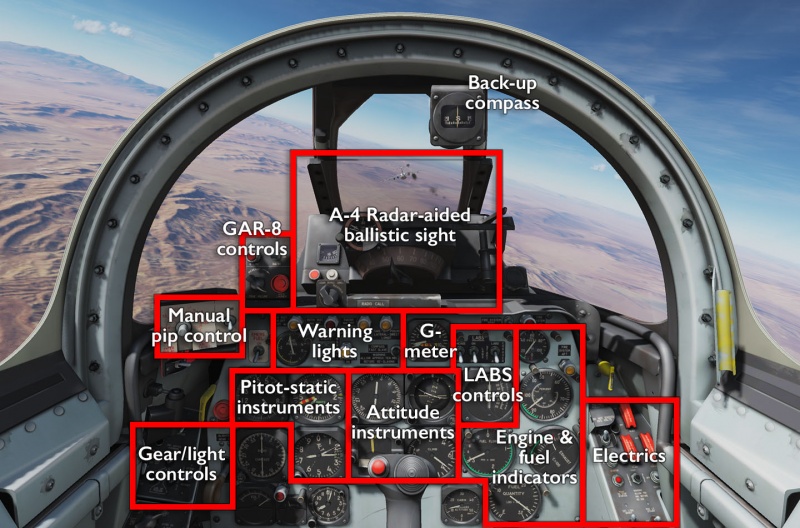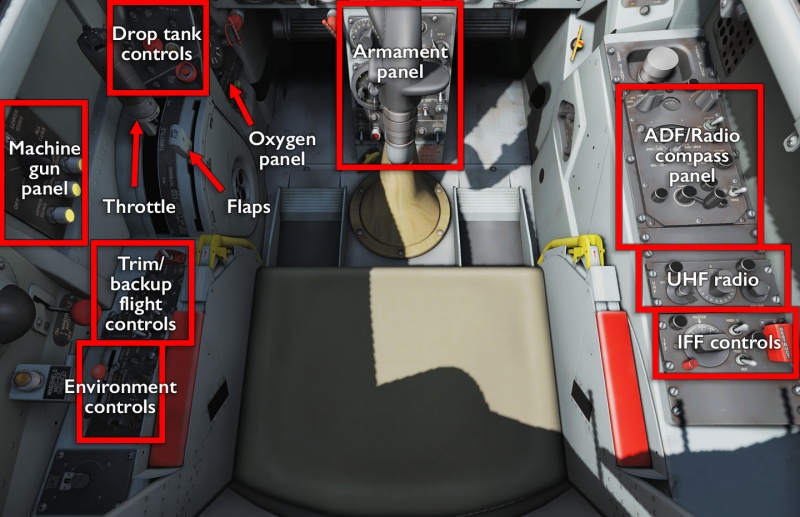F-86F Sabre: Difference between revisions
m (→�) |
m (→�) |
||
| Line 9: | Line 9: | ||
The features of the F-86F may seem trivial, but compared to, say the [[P-51D_Mustang|P-51D]], or even to the MiG-15, these are significant steps forward: | The features of the F-86F may seem trivial, but compared to, say the [[P-51D_Mustang|P-51D]], or even to the MiG-15, these are significant steps forward: | ||
* A tricycle landing gear with push-button nose-wheel-steering. | * A tricycle landing gear with push-button nose-wheel-steering and proper toe brakes. | ||
* Stand-off air-to-air capability with GAR-8 IR missiles (even though they are technically post-Korea). | * Stand-off air-to-air capability with GAR-8 IR missiles (even though they are technically post-Korea). | ||
* Stand-off''ish'' A2A and A2G capability with 4× .50" machine guns, guided by the A-4 radar-ranging sight. | * Stand-off''ish'' A2A and A2G capability with 4× .50" machine guns, guided by the A-4 radar-ranging sight. | ||
Revision as of 03:45, 8 July 2018
The F-86F was the most produced variant of the Sabre and made its mark in the skies over Korea as it, opposite the MiG-15, precipitated a new age of air combat — one dominated by the swept-wing jet fighter. The threat of potentially nuclear-equipped B-29 bombers demanded the introduction of the MiG-15 as a transsonic interceptor, which in turn demanded the introduction of the Sabre as a means to defeat those fast-moving interceptors using newfangled contraptions such as on-board radar and self-guided missiles.
In DCS World, the two Korean-war era fighters sit in a curious position, only slightly more advanced than the WWII-era fighters that preceded them, with very few systems to speak of, but with flight characteristics and handling that is much more in line with what we have come to expect from later-generation aircraft. They are no longer torque-heavy tail-draggers, but are not yet loaded with sensors or pilot aids or other automated system. The absolute first fledgling steps of the early jets have been taken, but some teething problems still exist.
Features
The features of the F-86F may seem trivial, but compared to, say the P-51D, or even to the MiG-15, these are significant steps forward:
- A tricycle landing gear with push-button nose-wheel-steering and proper toe brakes.
- Stand-off air-to-air capability with GAR-8 IR missiles (even though they are technically post-Korea).
- Stand-offish A2A and A2G capability with 4× .50" machine guns, guided by the A-4 radar-ranging sight.
- On-board sight adjustment calculator aid for manual bombing..
- Semi-automated low-altitude bombing system (LABS) for very fancy toss-bombing by way of doing loops over the target.
- More rockets than one would think strictly necessary.
- Speed brakes(!)
Flying the F-86F
The F-86F was designed to go high and fast, but at this early stage, the kinks in the high-speed jet design were still being worked out. When encountering high compressibility — close to mach speed, and especially at lower altitudes — it loses aileron effectiveness and is prone to unintentional rolling due to the wing design. Similarly, while capable of pulling high G:s and high AoA, doing so can easily result in stalls and spins, both of which require a fair amount of altitude to get out of, and if it picks up excessive speed during that descent, the aileron effectiveness issue kicks in and makes controlled recovery that much harder.
…but other than that, it's a really easy and hands-on aircraft to fly. Just be careful not to yank on the throttle too much, since that will tend to cause compressor which kills the engine and again requires a fair bit of altitude to restart. The temptation to do a lot of yanking is pretty high since it is not the most responsive engine in the world.
Cockpit overview
Getting into the air
Shooting something
Links and files
- Vehicle Size Chart for sight adjustments.
- Chuck's F-86F guide.
- DCS: F-86F Sabre by Belsimtek in the DCS shop.
Related DCS modules
- The Museum Relic campaign for F-86F and MiG-15.
More information
- North American F-86 Sabre on wikpedia.
- F-86 “Sabre” on globalsecurity.org
- Bunyap's Test Flight - DCS: F-86F Sabre video series.




